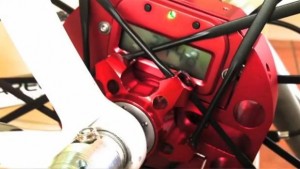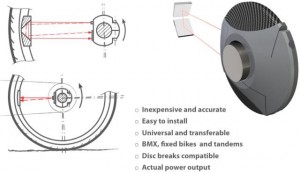 If you regularly visit cycling sites on the web, it is hard to miss articles about the benefits of training with a power meter. When the first SRM power meter was developed in the late 80s, it was definitely a training tool strictly for the pros. These days though, there are many more options available and it seems like the majority of cyclists I see on group rides are using some system to monitor their power. Of the power systems on the market today, the Look Keo and Garmin Vector pedal based systems are probably the easiest to install and use on multiple bikes (though you do have to switch both the pedals and the transmitter pods attached to the crank ark) . With retail prices in the thousands of dollars though, those systems are not reaching as broad a target market as they could at a significantly lower price point
If you regularly visit cycling sites on the web, it is hard to miss articles about the benefits of training with a power meter. When the first SRM power meter was developed in the late 80s, it was definitely a training tool strictly for the pros. These days though, there are many more options available and it seems like the majority of cyclists I see on group rides are using some system to monitor their power. Of the power systems on the market today, the Look Keo and Garmin Vector pedal based systems are probably the easiest to install and use on multiple bikes (though you do have to switch both the pedals and the transmitter pods attached to the crank ark) . With retail prices in the thousands of dollars though, those systems are not reaching as broad a target market as they could at a significantly lower price point
 Engineer Gennady Lubarsky aims to provide accurate power data to more cyclists with his Laser Spoke power meter, which according to the website is based on a “laser and position sensitive detector mounted on the hub, and an optical right-angle prism attached to the rim.” When torque is applied to the drivetrain, the hub-based sensor monitors the deflection of the wheel based on the beam projected back from the prism on the rim. Lubarsky claims that his relatively inexpensive optical system “delivers a level of accuracy similar to that obtained with most sophisticated systems available on market.”
Engineer Gennady Lubarsky aims to provide accurate power data to more cyclists with his Laser Spoke power meter, which according to the website is based on a “laser and position sensitive detector mounted on the hub, and an optical right-angle prism attached to the rim.” When torque is applied to the drivetrain, the hub-based sensor monitors the deflection of the wheel based on the beam projected back from the prism on the rim. Lubarsky claims that his relatively inexpensive optical system “delivers a level of accuracy similar to that obtained with most sophisticated systems available on market.”
 Currently, the project is on IndieGoGo, where you can see a 3 minute video that explains the concept. The current prototype relies on an SD card to transfer data to a computer after the ride, but plans for communication with ANT+ devices (including bike computers and smart phones) are in the works. It definitely sounds like an idea that has potential, so I am looking forward to seeing how the project progresses.
Currently, the project is on IndieGoGo, where you can see a 3 minute video that explains the concept. The current prototype relies on an SD card to transfer data to a computer after the ride, but plans for communication with ANT+ devices (including bike computers and smart phones) are in the works. It definitely sounds like an idea that has potential, so I am looking forward to seeing how the project progresses.

Leave a Reply to Bubba Nicholson Cancel reply